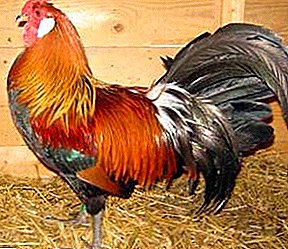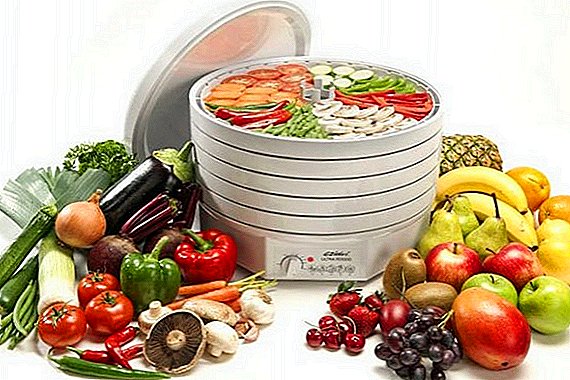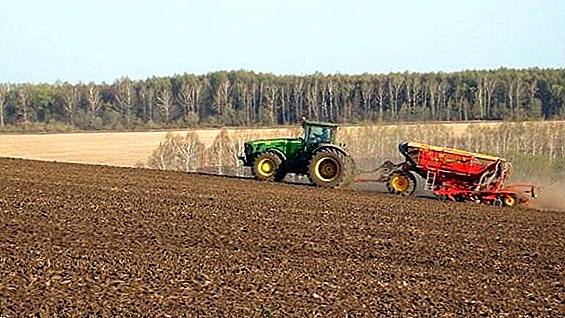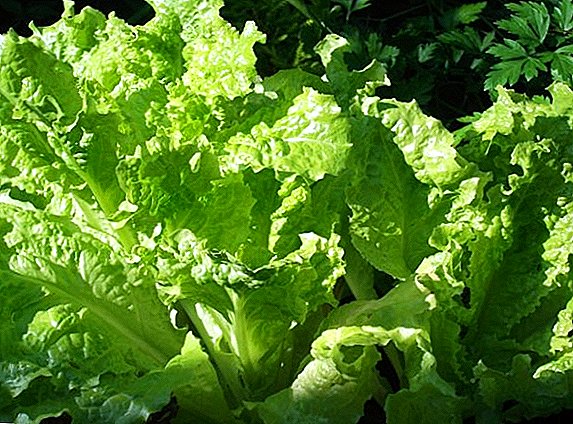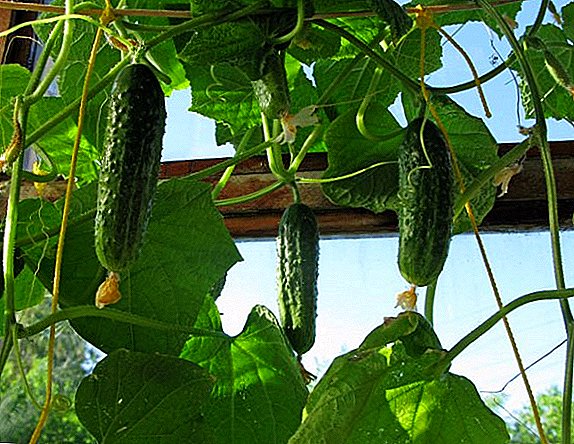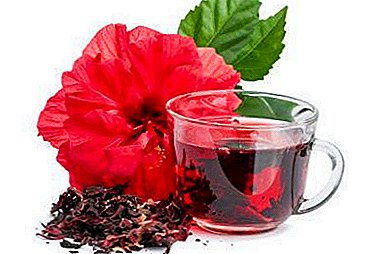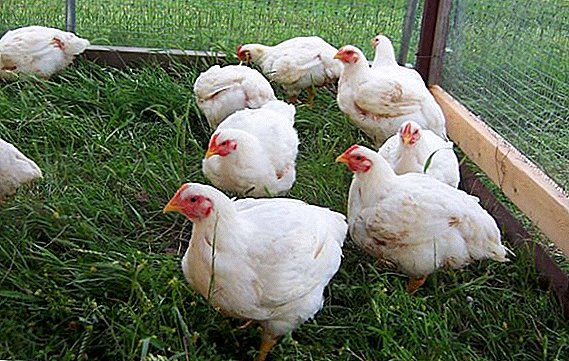 Broiler chicken is a frequent inhabitant of a domestic chicken coop, because it is a good source of meat that can be obtained in a fairly short time.
Broiler chicken is a frequent inhabitant of a domestic chicken coop, because it is a good source of meat that can be obtained in a fairly short time.
However, there are some nuances and features that need to be considered in order to achieve success in growing broilers.
Consider them in the article.
Benefits of growing broilers
Before you start breeding broilers in your own farm, it is worth exploring the pros and cons that this occupation entails. 
Let's see why poultry farmers grow broiler chickens:
- A large, usable individual grows very quickly - in 40-45 days, which makes it suitable for breeding even in a seasonal dacha farm.
- Fast-growing breeds of chickens can be kept throughout the year, creating the proper conditions for their existence. Valid also conveyor content.
- The meat in broiler chickens is tender, tasty and cooked quickly.
- The poultry breeder is always confident in the quality of his own products, because he knows what his wards ate and were treated for, what care they had.
- You can calculate in advance the cost of food, since it takes a certain amount of time to grow these chickens, and it makes no sense to keep and feed them longer than the required period.
- Broilers do not need areas for walking, their main task is to gain weight.
- The broiler chicken carcass plucks easily and quickly.

What kind of broilers worth taking for meat: the best breed
Broiler is not a breed name. The verb "to broil" in English means "roast on a spit", and broilers are called young poultry, bred precisely in order to get a lot of tender young meat.
Did you know? It turned out the first broilers from British farmers from crossing pedigreed chickens. They were very large and at first were assigned to a new gigantic breed, but subsequently they did not breed well and gave the usual offspring within a generation. So it turned out that by crossing meat chicken breeds, for example, Cochinchin, Brama, Cornish, Plymouthrock and others, you can get a fast-growing hybrid.
Consider the most common agricultural species used to quickly produce large quantities of meat:
- ROSS-308. Chickens of this breed are unique in that with proper care and feeding they are able to gain about 55 grams per day and already after six weeks are suitable for slaughter, gaining about 2.5 kilograms of weight. Chicken of the ROSS-308 breed that has reached the adult productive age enters the period of egg production and is capable of producing approximately 180 eggs. White plumage, light skin, low growth.
- ROSS-708. One of the last, extremely early breed. By the age of one month, chickens are gaining up to 2.5 kilograms. The color of their skin is normally yellowish, but often the carcass does not have time to get a yellow tint due to the speed of maturation and quick readiness for slaughter.
- COBB-500. It quickly gains muscle mass and at 40 days of age, when properly fed, has 2.5 kilograms of weight, which makes it suitable for slaughter. The cost of such meat is quite small. Chicken has large legs and breast. Survival in chickens is high, the bird in the herd is the same size. For high productivity it is recommended to intensively fatten in the first month of life. The plumage is white, the skin at the carcass is yellowish.
- Broiler-M The breed is a hybrid of small chickens and roosters, obtained from crossing the breed of the red Yerevan roosters and mini-chickens. The mass of an adult female is about 2.5-2.8 kilograms, the male is about 3 kilograms. At the age of five months, they enter the age of egg production and are quite productive. So, one chicken is able to give about 160 eggs per year. Due to oviparous productivity, representatives of the breed are considered universal. They are not distinguished by their powerful physique, and this allows them to be kept in more compact conditions, which is also promoted by the calm behavior of the described breed.
- Broiler-61. The hybrid was obtained by crossing two Corniches from the side of the rooster and two Plymouthrocks from the side of the chicken, due to which it is a four-line meat cross. It gains weight well at relatively low feed costs and weighs about 1.8 kilograms at 6 weeks. Differs in high survival rate and rapid growth, as well as high taste of meat. Rapid growth is not only a virtue, but also a lack of breed, because it does not have time to get bones strong, which may entail some problems, therefore, since five weeks of age, this breed is limited in nutrition.
- Gibro-6. Like the previous one, it is also a four-line rock. At the age of a month and a half, an individual gains 1.5 kilograms of weight, adding an average of 30 grams daily. Differs in good growth and high egg-yielding productivity (about 160 eggs from one hen). Well feathered, the bird has yellowish skin and fat of the same shade. Like birds of the Broiler-61 breed, they need to be limited in feed from 5 months due to the fragility of the bones.
- Change. One of the most popular breeds, obtained from the crossing of Broiler-6 and Gibro-6. Increments 40 grams of mass per day, the average egg production rate is about 140 eggs from a chicken. There is a high viability in chickens, but you should carefully consider their content in the first days, maintaining the temperature 2-3 degrees higher than the street one.







Important! Breeders are constantly working to improve the quality of hybrid crosses and their compliance with the stated requirements.
Which model is better to use
Breeding broilers in their own area does not require a large initial capital, but there is a need to study the issue of breeding such animals. Experienced poultry farmers do not advise starting with large volumes.
It is recommended to experiment with several individuals as an initial experience, as well as to obtain information about their own capabilities, costs and peculiarities of keeping such birds.
Did you know? Modern Canadian scientists (University of Alberta) simultaneously raised three breeds of broilers, popular at different times: in 1957, in 1978, and modern. The modern breed has demonstrated the rate of weight gain is 4 times higher than that of the predecessors of the 50s, while they eat food one and a half times less. This incredible property is acquired by lengthening the intestines and, as a result, better digestibility of food.
It should start with the acquisition of future meat giants:
- in the form of eggs for their subsequent incubation;
- day-old chicks for rearing;
- podroschennyh, more adult chickens.

Egg purchase and incubation
Buying eggs for meat hybrids for incubation makes sense when you plan to breed broilers. Incubation requires appropriate equipment, which costs a lot of money.
If the poultry farmer already has it, the purchase of eggs will be the most preferred way to acquire livestock, because eggs are cheaper.
Such a model, however, has certain risks:
- eggs may be defective or expired;
- the resulting breed may not meet expectations;
- Mortality of chickens with this method of breeding the highest.
You can minimize risks only by purchasing goods from a trusted supplier. 
Purchase day chicks
Having made the decision to purchase a daily young, you should take care of its proper transportation in advance, because the chicks are very vulnerable. This model is the most common, although significantly more expensive than the previous one.
Did you know? Broiler breeding is not a gene modification, but a result of selection, which was possible only in poultry. In fact, this phenomenon is an evolution, recreated by artificial means and having a negative result. Indeed, in the wild, such individuals would not have a chance of survival: they have low immunity, problems with the musculoskeletal system, myopathies, disturbances of metabolic processes, and so on.
But in this case, the poultry farmer can calculate their future costs and profits, based on the available livestock. There is some risk of death of acquired birds, most often due to maintenance errors. 
Purchase of older chicks
The practice is also the purchase of several older chickens.
In this case, the price increases with each day of their life due to the cost of maintenance:
- for food;
- on lighting;
- for heating;
- for drugs and vitamins;
- on care items, etc.
However, the risk of death significantly decreases as the chickens grow stronger, and among such young the percentage drops significantly. 
What conditions will be required for broiler breeding?
In the household, it is necessary to provide broilers with comfortable living conditions in order to receive by the time the planned amount of meat:
- the room should be windowless and well ventilated. An important point: you need to make sure that rodents and other pests do not have access there. Before settling the room should be washed and disinfecting treatment with 2% caustic soda solution. Also should be disinfected inventory;
Important! It is necessary to take into account the very rapid growth of livestock and plan the space, taking into account sanitary standards.
- It is recommended to use wood chips or sunflower husk as a litter, after making sure that it does not have mold, dust, chemical impurities, etc. When it is on the floor, it is important to ensure that the weight density per square does not exceed 34 kilograms, i.e. in the first days it can be from 30 to 40 individuals, after one month of age - 10-15 individuals;
- in case of cage content, which is more preferable in terms of epidemic safety, it is recommended to place up to 18 chickens and up to 9 adults on one square. It is recommended to contain from 3 to 5 chickens in one cage, but not more than 10 at a time. The cage design is such that all individuals must access the feed at the same time. The manufacture of cells requires costs, which, however, pays off if you constantly practice the breeding of poultry, and after that the efficiency of the method increases in comparison with the floor content;
- In the first week of life, chickens must be provided with a temperature regime of about + 32-34 ° C, in the second week the temperature drops to + 30 ° C, and in the third week - to + 27 ° C. Subsequently it is necessary to adhere to + 21-22 ° C. Of course, in the winter, broiler breeding is possible only if there is a heated chicken coop;
Did you know? An individual member of the herd withdrawn from the hen house for a few days will be recognized upon return and will receive it.
- it is not necessary to equip the chicken coop with bright lamps, however, it should be noted that the lighting should be present for the first 2 weeks around the clock, then the light turns off for an hour per day. At the same time, the eating and eating areas of the chickens should be well lit;
- The room must be ventilated without fail, but no drafts should be allowed - they are destructive for meat hybrids;
- when keeping domestic flocks on the floor, it is necessary to install a sufficient number of feeders and drinkers in the hen house so that each chicken has easy access to food.
Important! Using the inventory again, each new batch of chickens should be placed in a disinfected cage.
With the cellular content of the feeders and drinkers are made removable in order to be able to wash them frequently. Feeders attach along the front wall of the cage, drinkers - above them. In order to avoid the spread of diseases, dishes should be cleaned regularly and disinfected from time to time, especially for subsequent batches;

What to feed
In the issue of growing hybrid meat crosses on natural mechanisms in their feeding can not count. This is a fast-growing meat, which should be grown, adhering to clear feeding schemes, if you want to get the planned weight in a short time.
It will be useful for you to learn how to feed broiler chickens correctly, how to feed broiler feed and how to cook it yourself, and also learn how to properly feed PC 5 and PC 6 for broilers.
Each period of this bird's short life requires a certain set of necessary substances. There are ready-made feed that correspond to each such period.
Some poultry farmers who have experience in broiler breeding have the opportunity, by sampling, after studying the material, to combine food with their own hands.
Did you know? It is believed that chickens are direct descendants of dinosaurs, namely tyrannosaurs. This theory confirms the similarity in the structure of the skeleton, as well as the ability of chickens to navigate well in space and run fast. In addition, they have excellent vision.
Many farmers manage to prepare a combined fodder on their farm, especially if it contains dairy production waste, garden greens, and so on, and this significantly reduces the cost of broiler feed and, consequently, increases the profitability of their maintenance. 
The classical scheme of feeding broiler birds is reduced to three types of food, alternating sequentially in accordance with the age of the population:
- prelaunch, which is given to chickens in the first five days of their life;
- to the starter who are fed the growing herd up to one month of age;
- finish, which is the main power to slaughter.
Important! Regardless of the age of the livestock, gravel in the feeders should always be freely available along with the feed.
Chickens of the first five days
Immediately after hatching, chickens should get a sweet drink: a liter of water with a teaspoon of sugar diluted in it.
Following the first watering, many poultry farmers recommend giving chopped boiled eggs as a first feed, but others object to them - this can cause digestive upset in young animals, and they are advised not to give wet food at all, but to offer millet mixed with egg powder.  For those who want to make their own pre-launch feed, there is such a recipe: corn - 50%, wheat or wheat bran - 16%, milk powder - 13%, soybean meal - 13%, barley - 8%.
For those who want to make their own pre-launch feed, there is such a recipe: corn - 50%, wheat or wheat bran - 16%, milk powder - 13%, soybean meal - 13%, barley - 8%.
Chickens of this age eat up on average about 10 grams of feed per day, increasing the dose day by day, and by two weeks of age the consumption increases to 25 grams per day.
Be sure to freely available should be fresh water, which, as needed, add or 1-3 crystals of potassium permanganate, or sugar (glucose).
Did you know? Ayam Chemani is a breed of black chickens and roosters. And thanks to the dominant black gene, they have not only plumage, but also skin, bones, muscles, and internal organs. They even have blood much darker than usual.
Chickens from six to 30 days
Six-seven-day chicks are transferred to starter feed, and at this age it must be moistened by preparing mash on whey, adding cottage cheese, brewer's yeast, chopped egg, egg shells, onions, which fight parasites in the intestines. Gradually adding greens to food, you can bring its share to 10%.  For those who want to make their own starter feed, there is a recipe: corn - 48%, soybean meal - 20%, wheat - 12%, fish meal - 7%, beer yeast - 5%, grass meal - 3%, milk - 3%, fodder fat - 3%, chalk - 1%.
For those who want to make their own starter feed, there is a recipe: corn - 48%, soybean meal - 20%, wheat - 12%, fish meal - 7%, beer yeast - 5%, grass meal - 3%, milk - 3%, fodder fat - 3%, chalk - 1%.
Norms of feed intake by a 1-4 week old bird - 20-120 grams per day.
Up to 10 days of age, young chickens are fed 8 times a day in small portions. When they peck everything offered, they sprinkle a new portion of food.
Important! An uneaten, wet food should not be left in the feeders: it can sour, and the bird will get food poisoning, and the host will have consequences associated with this unpleasant phenomenon, one of which will be slowing down the weight gain.
From time to time, manganese is added to water from time to time. 
Fattening broilers for slaughter
One month after the birth, the bird is transferred to the finishing feed and fattened for maximum weight gain up to the age of two months.
Adding food waste is welcome in feed:
- potato peelings;
- vegetable scraps;
- rind boiled vegetables, eggshell;
- grain residues and the like.
However, care should be taken to ensure that the waste was free from mold and rot, otherwise the chickens will get intestinal problems.
For those who want to make their own starter feed, there is such a recipe: corn - 45%, cake - 16%, wheat - 14%, barley - 8%, brewer's yeast - 5%, fish meal - 4%, meat and bone meal - 3%, feed fat - 3%, grass meal - 1%.
Important! The transfer from one feed to another is always carried out gradually so as not to disturb the digestion of the bird, which may respond to this by slowing down the weight gain.
A day in the second month of life, a broiler consumes from 140 to 160 grams of feed. 
Disease prevention and fortification
Будучи искусственно выведенным гибридом, бройлер подвержен заболеваниям другой домашней птицы.
Did you know? On our planet, chickens live three times more than people.
Poultry breeders involved in their cultivation need preventive procedures on time and regularly:
- At 1-5 days of life, bacterial diseases are prevented, for example, by drinking Enoxil diluted in water in a ratio of 1 milliliter of product per liter of water.
- One of the days from 6 to 10 is devoted to fortification, for which 1 ml of Vitasol is diluted in 2 liters of water or 1 ml of Chiktonik is given in a liter of water.
- On day 11, chicks are vaccinated against Gumboro disease. The amount of the drug that is contained in one bottle, you can immunize 50 goals.
- On days 12-16, the fortification is repeated.
- The 18-day-old bird should be revaccinated for Gumbore disease at the same dosage.
- The next, 19th day, repeated fortification is carried out.
- One of the days from 21 to 23 is devoted to the prevention of coccidiosis, for which 2 grams of Tromexin or 1 gram of Baycox are diluted in a liter of drinking water.
- From day 24 to day 28, vitaminization is repeated.
It will also be useful for you to find out which diseases of broiler chickens are considered infectious and which are non-infectious, and also find out why broiler chickens die and how to treat diarrhea in broilers.

How many broilers grow for meat and when is it better to cut
Since the main goal in growing broilers is to get the largest possible quantity of meat in a short time, it makes no sense to keep them longer than they should be: after they gain weight slowly or completely stop, and they still eat a lot. Mass is gained mainly due to fat.
The taste of meat also changes for the worse: it becomes hard and dry.
Depending on the breed, the bird is ready for slaughter in 6-8 weeks.
Live weight broiler meat output
Meat yield is the difference in the weight of a gutted and plucked carcass without paws and head and the weight of a live bird. Output is calculated as a percentage.  It is believed that in broilers this value ranges from 60 to 80%, the average yield is 70%. However, much depends on the breed, conditions of detention, past diseases and other factors.
It is believed that in broilers this value ranges from 60 to 80%, the average yield is 70%. However, much depends on the breed, conditions of detention, past diseases and other factors.
In order to grow broilers, you have to work hard - this is a rather troublesome business, but the beginning poultry farmer can cope with it with some theoretical training. Growing such a bird does not take much time, and the output is tasty and tender meat, much better than the quality of the store.


